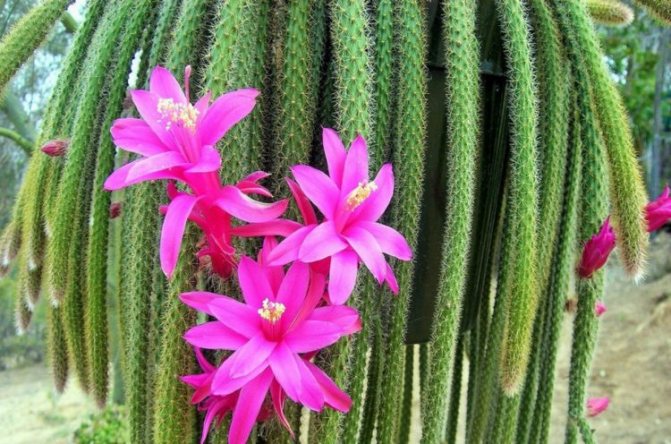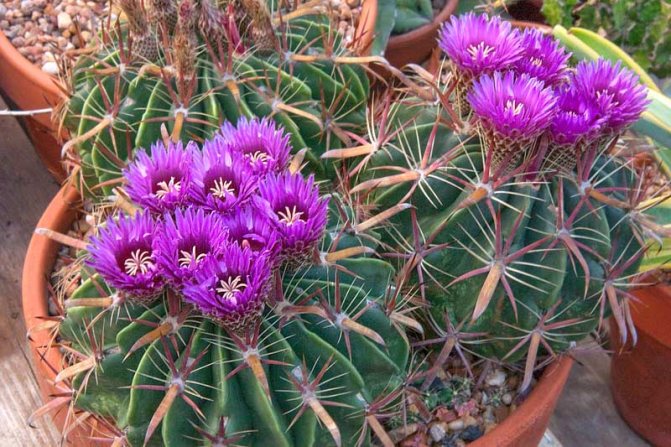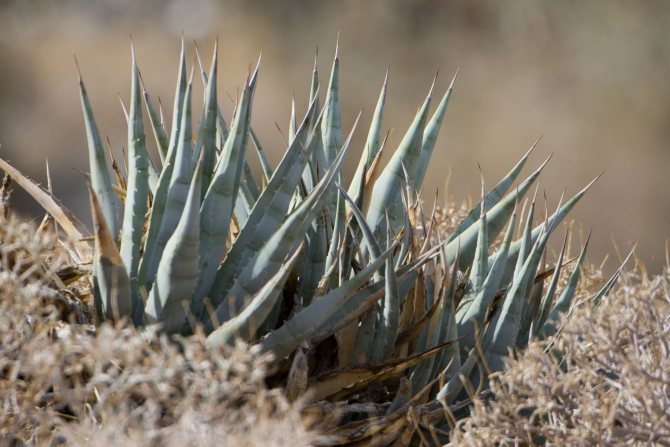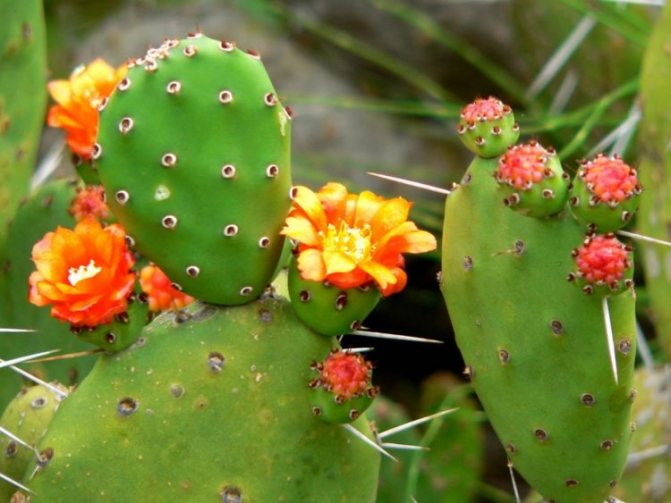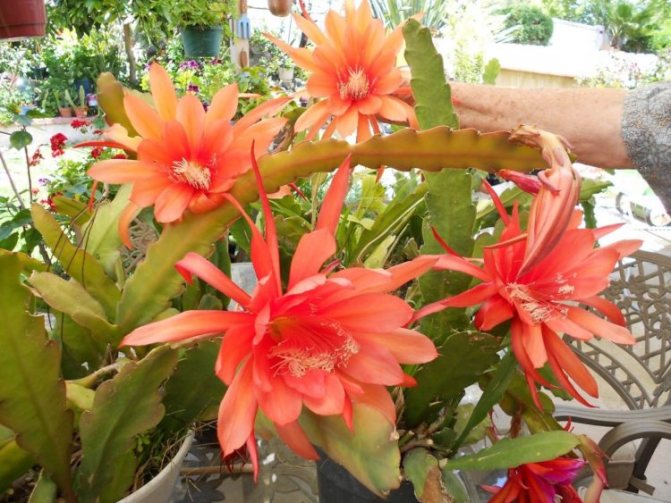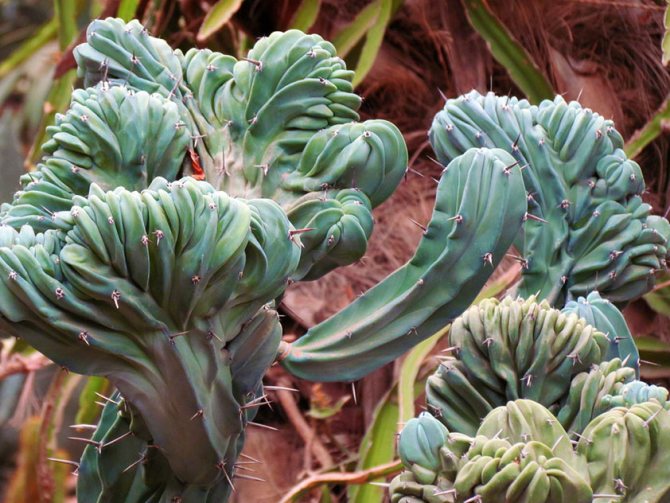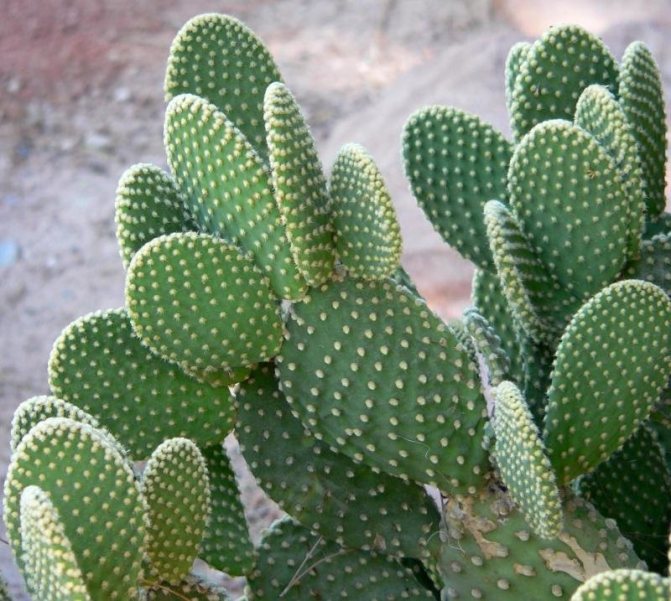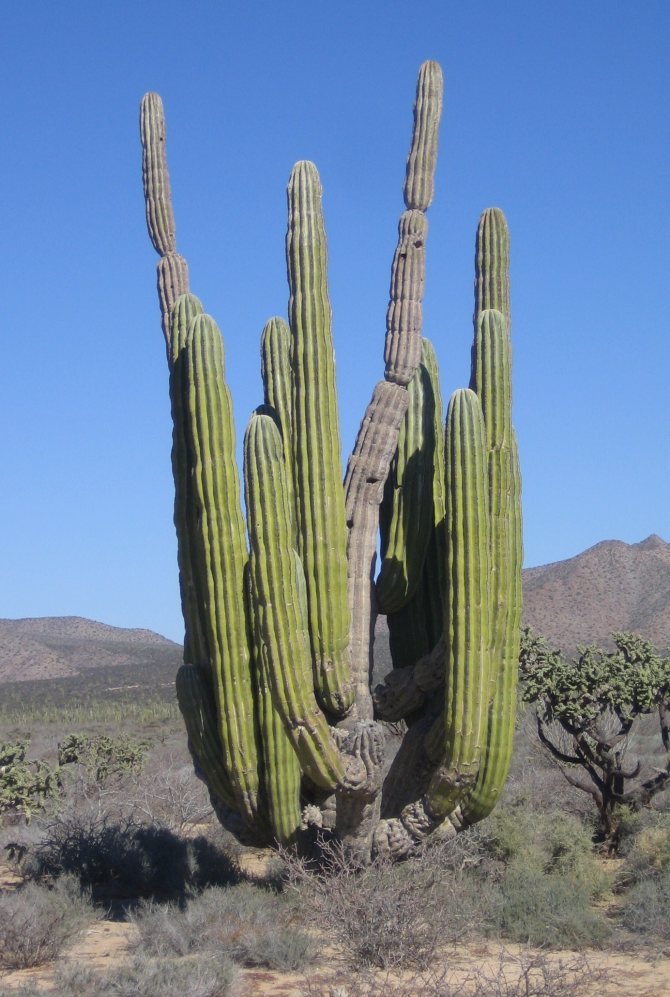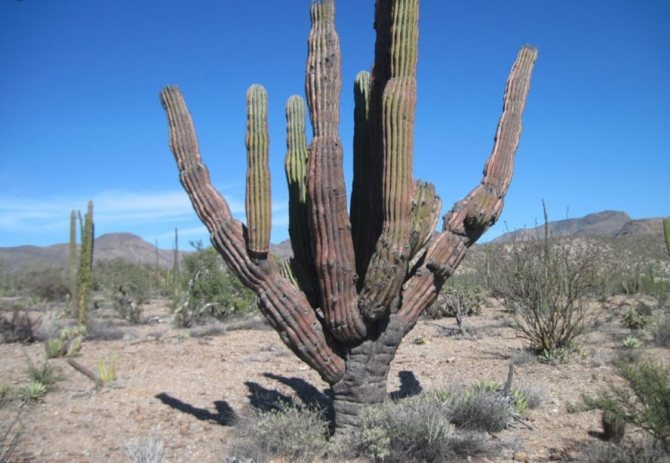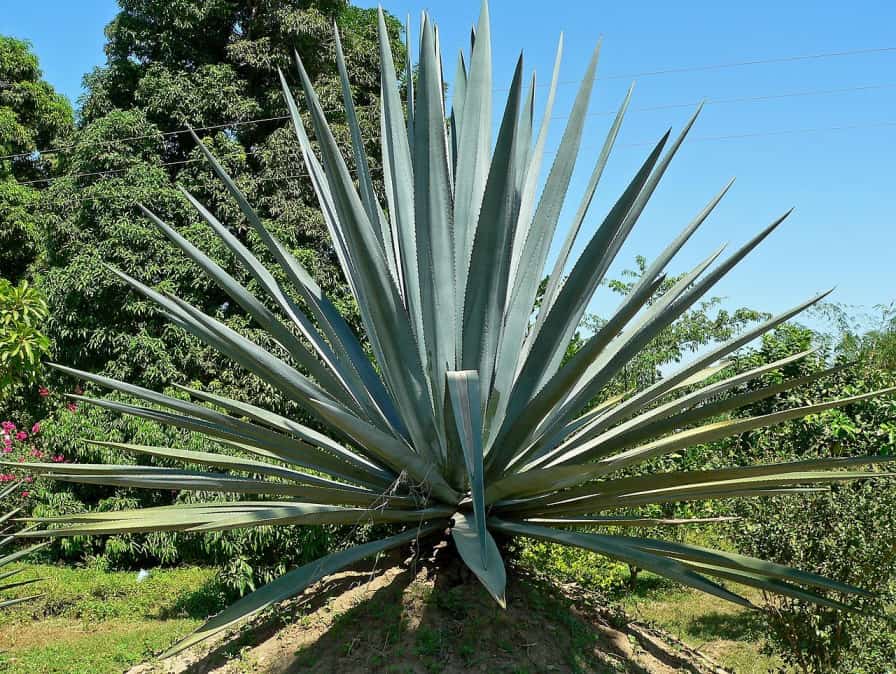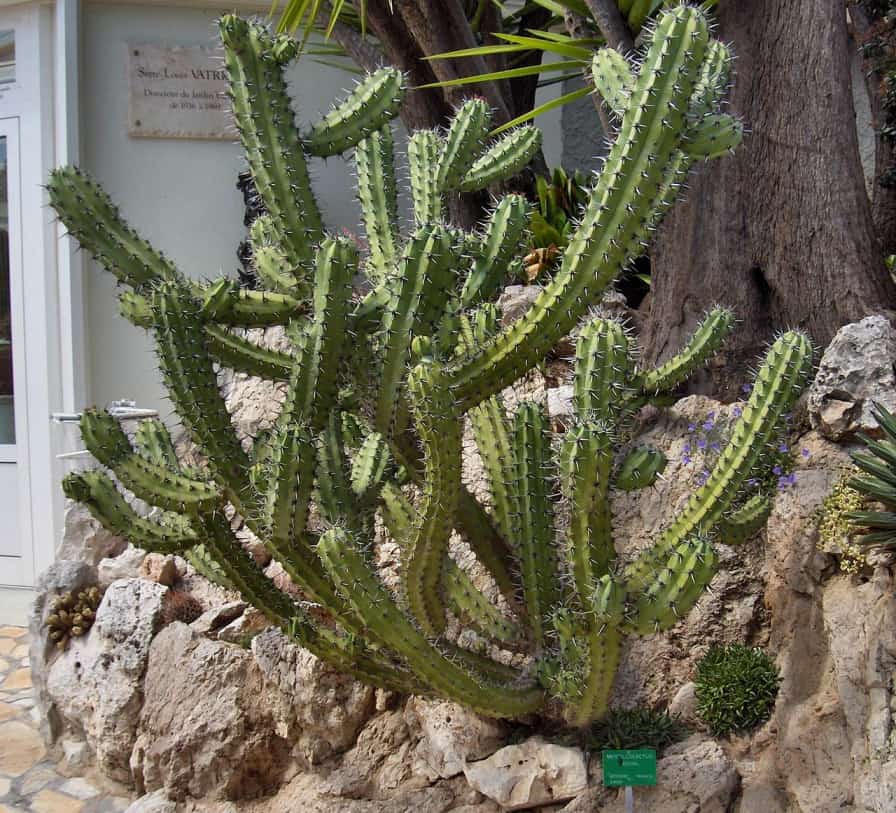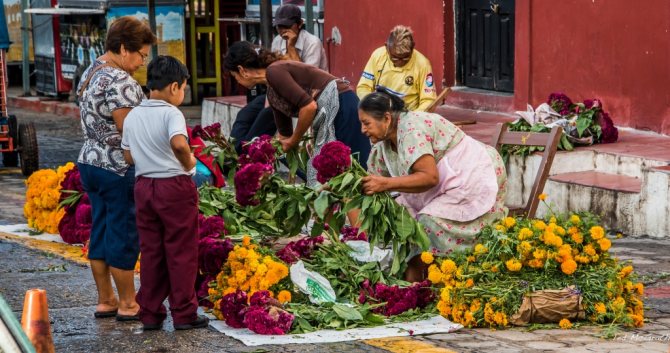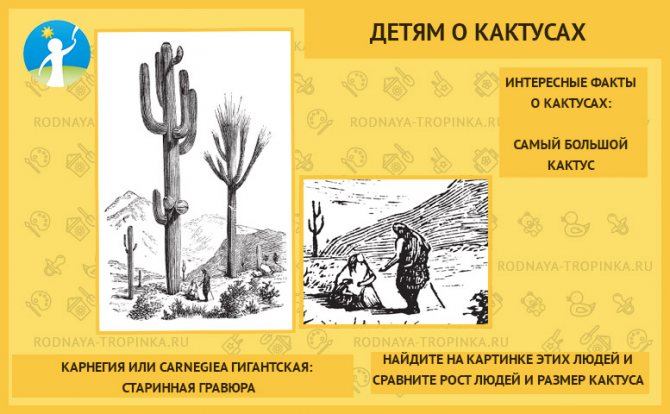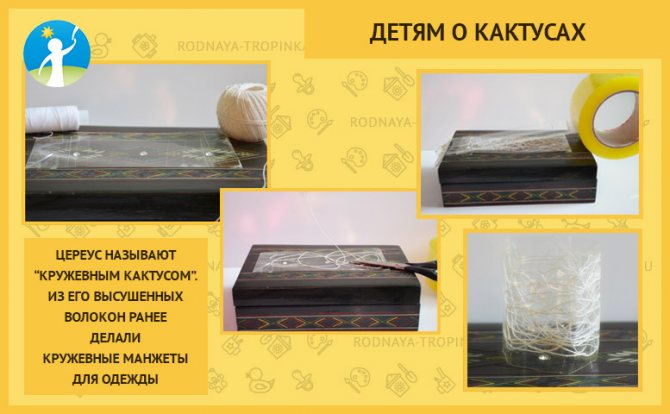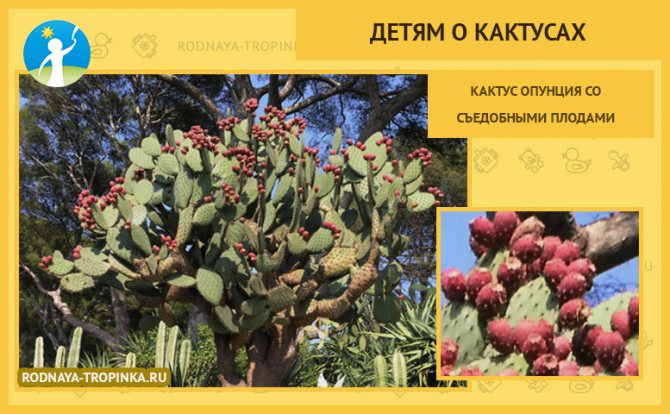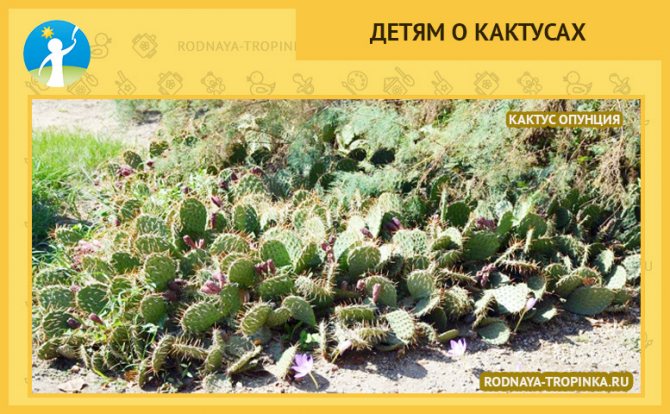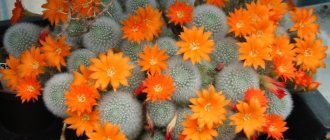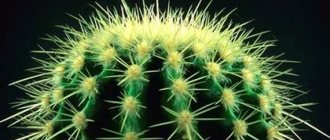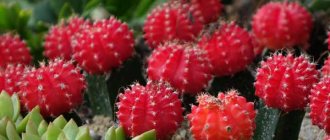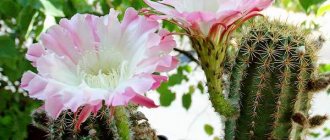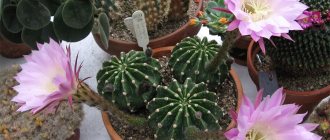Mexican cacti are a national treasure of the country. And even on the coat of arms of Mexico there is an image of the prickly pear cactus. They originated in Central America, but then moved to the coast of the Gulf of Mexico, where the hot and humid climate favors the growth of these plants. It is believed that Mexico became a country in which about a thousand new species of cacti appeared. Many tourists come to the country to admire the amazing world of these wonderful plants.
Views
- - the stem of this genus is very low, flattened. Some have thin white stripes. In the axils of the tubercles, such succulents have fluff. Blooms truly amazing
; - - a species that has a spherical shape. It is found mostly in the southern part of the United States. The ribs are quite sparse. The stem is strewn with fine hairs along
... There are very beautiful varieties that resemble a star; - Aztekium is a genus formed by two species. The shape is round, wrinkled, weak spines
; - - there are a lot of representatives of this species, they are united by one feature - flower tube
, many have fluffy, he has it completely naked.The ribs are separated by transverse tubercles. Green, brown or gray stem.
There are very interesting varieties that are devoid of chlorophyll, from this their color is red, yellow, pink
;
- - a genus of cactus, the trunks of which resemble sausages in shape, long, cylindrical. The needles are thin and very dense, the flowering is abundant;
- Coriphanta - has approximately 60 kinds
... The stem is spherical, but may look like a cylinder. Spines up to 2 cm in length, grow in groups, form a "snowflake". Flowers can be up to 10 cm in diameter; - Leuchtenbergia is only one species in this genus. Stems resemble agave
because of its elongated tubercles and thin tendril-like needles; - Lofofora is a genus from Central Mexico. By the appearance of the plant resembles a pumpkin
... The surface is smooth, there are practically no spines.Juice causes hallucinations, prohibited from collection in the wild;
- – very common type
... Small round, wart-like tubercles - the stems are collected in groups. The spines are not sharp, smallish flowers of various shades, form a spiral at the tips; - Matucana - named after the Peruvian province. The shape is round. Some do not have spines, if there are, then rare long, curved ones. The flower is large with a tube emerging directly from the center;
- Myrtillocactus - the trunk is smooth, the ribs are rather sparse, the needles are dark, long, flowers are barely noticeable
; - Obregonia is a rounded stem with extraordinary rims-tubercles with fluffy tassels. The flowers are white, resemble a daisy
; - - a cactus on the one hand is an aristocrat, on the other - a hedgehog.
The size very tiny, blooms for a very long time, many varieties;
- - small balls from the mountains of Argentina, grow in groups, bloom profusely, flowers form a spiral at the bottom of the stem;
- - the shape of the trunks resembles barrels with pronounced ribs and powerful thorns, flowers appear at the very top of the head;
- - is he huge
... At home, it grows up to 40 meters in height, has a powerful root system, ribbed, weakly expressed thorns, several flowers are formed on the trunk; - - the stem is long, there are hairs on it, sometimes very thick, white, soft, the flowers are original thick;
- - very common, grows on windowsills
... They are round, but more often they stretch out as they grow. The ribs are even, smooth, the spines vary in length, the flowers are spectacular, located on long flower tubes; - - the simplest epiphyritic genus. The stems are rather thin, often hang down, the color is bright green, densely covered with needles
, flowers are elongated, bright pink, located along the stem. Flowering is short - up to 4 days; - Blossfeldia - genus of the most compact cacti
... It has 11 ribs, there are no thorns. An shoot develops under the epidermis, this layer gradually cracks, and the baby crawls out. There are species with a depressed apex; - – miniature
, no more than 4 cm in diameter. The spines are thin, form a white coat around the stem, but the flowers for it are very large, orange, up to 3.5 cm; - Hageocereus - named after the author of books about cacti V. Hage.
Representatives of this species in nature reach three meters in height with a diameter of 25 cm.The flowers are red, elongated;
- - genus with elongated stems, similar to flat leaves, small, white thorns. Does not bloom on the windowsills
; - - the stem is most often spherical, sometimes cylindrical, covered with hairs, ribbed, powerful needles. Flowers are usually bright red, rarely white or pink;
- - an epiphytic cactus resembling a shrub, as it has a ligneous base and a leaf-shaped fleshy stem with jagged edges. There are thorns along the edges of the stem. The flowers are large with a strong aroma.
June 18, 2014
The American state of Arizona is famous for its attractions. Real wonders of nature - huge saguaro cacti are so unique that they are the pride of the United States.
The giant cactus flower is the emblem of the state of Arizona. This is how the Americans paid homage to the unique plant.
Section 5. Cactus: coloring for children
And at the end of the article for its youngest readers - coloring pages of cacti! Color and create your beautiful cactus garden in a picture - applique, postcard or album.

More about cacti: interesting ideas, fascinating materials for games and activities with children can be found in the articles "Native Path":
- "Craft for children: blooming cactus Princess of the Night." A story for children about an unusual cactus and a step-by-step master class
- Poems about a cactus for children: 23 poems for toddlers, preschoolers and schoolchildren, as well as comic poems about a cactus with tasks for children. - Riddles about cactus for kids: 23 riddles for preschool and primary school children about cacti. Riddles from the simplest to the most difficult.
What are cacti
Saguaro is a real record holder among his fellows. Its average height reaches 15 meters! In 1988, a cactus of incredible size was discovered in Arizona. The thorny giant reached a height of almost 18 meters.
Today, the record belongs to a cactus, which grows all the same, in the Arizona Sonora, in Maricupa County. 3 meters in girth and 13.8 meters in height - these are the dimensions of an incredible plant. Carnegia giant is the scientific name of this plant.
There are a lot of similar giants in this desert. Their sizes are a little "more modest". California and Mexico have a small number of giant succulents, but most of them are in Arizona.
The largest cactus in the world weighs almost 8 tons! Some plants are up to 150 years old!
Like many succulents, saguaros grow very slowly. Only 1 meter in the first 30 years of life is the growth rate of a young plant. For the next 40-50 years, the cactus grows 1mm in height every day.
By human standards, by old age (at the age of 75), the sagurao reaches its gigantic proportions: a huge, thick trunk and many lateral processes are clearly visible from afar.In this huge house one could live, fleeing the heat and drinking tequila, obtained directly from the walls of a fantastic plant.
The saguaro flower is very delicate and beautiful. It blooms at night. There are hundreds of stamens among the white petals. Some of them are so large that small birds build nests between them. The first flowers appear only when this unusual plant is 50 years old.
Prickly pear
Opuntia in its kind has about 200 cactus plants. They preferably grow in deserts, savannas and semi-deserts.
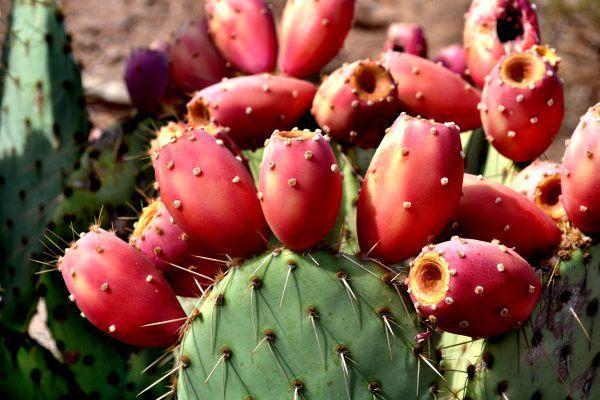

Mexico is the homeland of most prickly pears, which is why they are called simply Mexican cacti. These are large trees up to six meters high, which bloom beautifully from April to September. Plants are often used to protect the soil on mountain slopes from erosion. Fruits are highly prized as fruits. The local population uses prickly pear stems for livestock feed. Aromatic tea is brewed from the flowers. Plant extracts are added to cosmetics and medicines.
Saguaro National Park
Unique giant ones grow only in the Sonoran Desert, which stretches from Arizona to Mexico. The state protects these unusual forests, where dense thorns are visible on the trees instead of leaves.
Since 1933, the territory of the desert is a nature protection zone. Even when building roads or any structures, it is taken into account whether the construction will damage the natural attractions of the United States.
In 1994, it appeared, the basis of which is the territory of the Green Desert. This is what Sonora is called. This desert is fundamentally different from other desert areas.
Yes, it is also very hot here, but at the same time, more than 30cm of precipitation per year falls on this land. A variety of biological species, flowering plants coexist with sandy deposits.
49 types of cacti grow here. Diverse, unlike each other, thorny desert dwellers coexist with giant saguaro. These bizarre shapes attract hundreds of thousands of tourists who want to see not only huge cacti, but also the unique world of the Green Desert. Desert turtles, cougars, snakes, lizards, foxes, bakers and other animals are found here.
Saguaro cacti of incredible size delight all visitors to Arizona. Tourists enjoy taking pictures next to the thorny giants.
Giant saguaro cacti in the Sonoran Desert photo
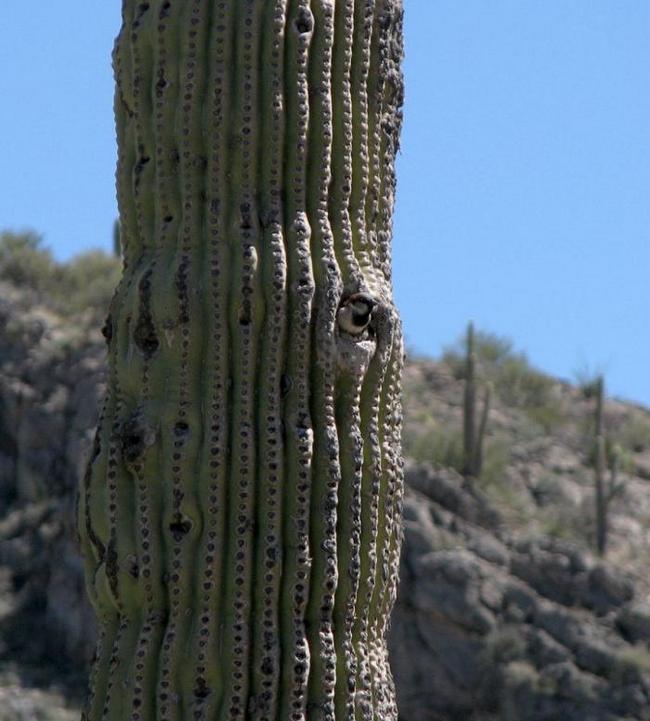

The desert differs from other places in a very dry and hot climate. Plants have developed many adaptations to grow and live in such arid places. An example is various types of thorns, with the help of which you can not only gain a foothold on, but also accumulate a certain amount of moisture in reserve. The well-known camel thorn has almost no leaves.
The roots of desert plants have unprecedented power, they go deep into the soil, thereby providing access to groundwater. For example, sand sedge penetrates with its roots to a depth of 70 cm It is often possible to find plants with rather fleshy or even trunks. This is another way to store water in reserve.
In the desert, there are shrubs and even trees, only their distinctive feature is their low height. The trunk can be perfectly straight and elongated, like in acacia, or curved and literally adjacent to, like in saxaul. Plants are rather scattered from each other, their crowns never touch.
Carnegia
The Carnegia giant cactus (Saguaro) grows in the arid deserts of northwestern Mexico. It is a huge plant with a height exceeding 15 meters and a weight of more than 8 tons. Saguaro's lifespan is more than 150 years. The plant continues to struggle for its existence all its life. Fallen tree seeds only germinate after heavy rainfall.The emergence of a carnegia sprout near a shrub or tree gives the plant a chance of survival. Close proximity allows Saguaro to hide from the weather and wind, as well as absorb water and nutrients from under it.


As a result, the tree-like cactus gains strength, strong roots grow, and the plant turns into a huge tree, and the protector and source of its nutrition dies. Carnegia grows slowly and reaches one meter only by twenty years of existence. The mature age of a cactus occurs only at 50–70 years. At this time, it begins to bloom and branch. During the rainy season, it is saturated with water and bursts, and new shoots appear from the cracks. The plant is well adapted to hot climates. Its top is covered with white thorns, which lower the temperature of the tree by five degrees. Mexico has a national park, visiting which people enjoy the beauty of giant cacti.
What plants grow in the desert
When they talk about desert plants, the name immediately comes to mind, like a cactus. A large number of cacti grow in the desert, they have various shapes, sizes, some even bloom. They grow singly or in whole colonies. Cacti have a fleshy body and a special fibrous tissue that retains moisture. Some desert cacti are real long-livers, their age reaches 150 years.
An unusual and majestic plant can be called the baobab. It has just a huge trunk, which can reach 9 meters in diameter. During the driest times of the year, the tree simply sheds its leaves to reduce the amount of moisture it draws. And the baobab blooms, then fleshy and rather tasty fruits appear. The tree is very tenacious and resistant to lack of moisture, it can launch roots quite deep into the soil in search of water.
The blooming desert is considered the most stunning sight. This is just an incredible picture to see. After it rains on the desert, literally. Flowers are mainly bulbous, which are also capable of storing moisture for a long time. However, you can also find primrose vervain, which bloom in all its glory after the rainy season.
The flora of the desert and unusual. In conditions of drought and the absence of normal fertile soil, plants manage not only to bloom, but also for long years are fixed in the sands.
Cacti evoke associations with a round green hedgehog planted in a small pot, but this is absolutely not the case - different species are suitable for indoor cultivation, which botanists divide into 4 groups. This article provides detailed agricultural techniques for growing forest and desert cacti.
The adorable thorny plants belong to the Cactaceae family.
Among indoor plant lovers, there is a fairly large group that collects cacti and other succulents. Why did they choose these plants? A prickly indoor cactus does not take up much space, and caring for this plant is quite simple. During flowering, it is impossible to take your eyes off the plants - bright spectacular flowers on a thorny ball can delight any grower.
Botanical reference
It is hard to believe that perescia is also a cactus.
The modern classification involves the division of plants of this species into 4 subgroups:
Pereskioideae
This group includes only one representative (peresky prickly), which botanists refer to as a transitional species between deciduous plants and cacti proper. Pereskia has long liana-like stems with sparse thorns and large elliptical leaves. The unusual plant blooms with amazing creamy flowers, but they can only be seen on mature plants.
They grow in South and Central America.
Opuntia (Opuntioideae)
Prickly pears are often grown as home cacti.It is easy to distinguish this species from others - the body of the plant consists of flat thick cakes covered with special small thorns (glochidia). The plant uses small thorns to protect it from being eaten by animals.
Among the prickly pears, there are miniature and giant species; this species from natural habitats has settled throughout the continent, where it can winter without shelter. In Russia, the natural areas of prickly pear can be found in the Crimea, in the Caucasus, in the Lower Volga region. Opuntia bloom in large flowers, similar to luxurious roses, the fruits of some species are edible.
Mauhyenous (Maihuenioideae)
Includes one genus native to Patagonia. This variety is very similar to prickly pear, but does not have glochidia.
Cactus (Cactoideae)
The largest family includes species that grow in deserts and forests. On home windowsills, you can often find original specimens that are part of this group of plants. Outwardly, desert and forest cacti are not at all similar - the former have abundant thorns, the latter are similar to segments, their flat leaves do not have thorny outgrowths at all. The care of these cacti is also very different, which is associated with the different growing conditions of the species in nature; agricultural techniques for caring for home cacti will be discussed below.
How to make cacti safe for small children?
The only negative thing about cacti is their thorns. In childcare facilities, you should avoid:
- prickly pear, which easily loses its thorns,
- Trichoceruses, which have powerful long spines.
But cacti are a very colorful and interesting object to study, you shouldn't give it up. Even the smallest children can be grouped with cacti by planting them in plastic jars.
Of course, glass jars or an aquarium would be preferable, they give more light to the plants, but plastic is safe, it will not break. In addition, a hole can be made in its bottom with a red-hot awl.
Desert
Blooming mammillaria.
Many types of home cacti, which are successfully grown by amateurs on a sunny windowsill, belong to the desert group. These plants have a pronounced dormant period, so it is important to properly care for the thorny pets during this time.
Desert cacti are accustomed to sudden changes in day and night temperatures, put up with prolonged drought and scarcity of stony soils, but the harmonious development of these plants is impossible without sunlight. If you decide to start a collection of thorns, you will have to free up a sunny window sill for them.
Desert cactus species
Composition of desert species.
This subgroup includes most of the spiny varieties, including prickly pears. Very often, on the windowsills of amateurs, you can find a representative of the genus Mammillaria - round or oval low cacti grow in colonies. Their spines are small, thin, and have tenacious hooks at the ends.
The whole body of mammillaria is covered with papillary outgrowths, the flowering of plants occurs at the top, small flowers of pink, white, crimson or yellow bloom in a circle. During flowering, mammillaria look like green hedgehogs with wreaths on their heads. After flowering, in place of flowers, fruits are formed, in which seeds ripen. Mammillaria grow easily and quickly from seeds, seedlings adapt well to local conditions, forming charming spiny balls.
The prickly pear is protected by small spines that densely cover its body.
Spectacular parodies with large bright colors can often be found in the collections of experienced and novice amateurs. The body of a cactus (rounded or elongated) is densely covered with long hairs, among which sharp spines are hidden. The original appearance of the plants is given by multi-colored pubescence, as well as surprisingly bright and large flowers.
Globular rebuts growing in groups come in many varieties.Large funnel-shaped flowers rise along the body of the cactus from the bottom to the crown. Long-lasting flowering, flower petals are painted in red, pink, crimson tones - very bright.
Ferocactuses, aztekiums, astrophytums, echinocactuses are ranked among the elite of desert cacti. Mature plants are quite expensive but can be easily grown from seed. Elite species have a round (sometimes flattened-rounded) shape, original spines and a ribbed body.
Rare cacti have huge flowers, the diameter may be larger than the parent.
A large group of columnar-shaped species of cacti belongs to the species Cereus. Cereus usually grow in colonies, have an elongated shape and resemble a rock. In nature, cereus grow to gigantic sizes (over 40 m).
Very often, on the windowsills of amateurs, you can find echinopsis - this cactus is not very original in shape, but during flowering it can please with huge flowers of an elegant shape. Echinopsis can have a round or cylindrical shape, easily overgrow with numerous children, which can be used for vegetative propagation of the plant.
Agrotechnics of care
Desert cacti require bright lighting, dry wintering at moderate temperatures, and careful watering. You can water the plants only during the growth period, in winter cacti go to rest, they need to find a bright place at a temperature of + 10 ° C, reduce watering (you can not water at all for 2 months), but with the arrival of spring, plant care is resumed, moisturizing the plants once per month.
It is best to prepare the soil for planting yourself; store-bought mixtures made on the basis of peat are absolutely not suitable for growing thorny pets.
Each type of cactus requires planting in a certain land mixture, I will give an example of the classic soil composition for prickly people from desert regions:
- Sod land - 1 hour
- Leafy ground - 1 tsp
- Clay - 0.5 tsp
- Coarse sand - 1 tsp
- Small pebbles, brick chips or crushed crushed stone - 0.5 h.
For planting echinopsis and cereus, peat and humus should be added to the mixture for 0.5 tsp.
It is important to remember that acidic soil is not suitable for planting cacti, the ideal Ph value is not higher than 6.5.
Desert cactus planting medium should not be filled with nutrients.
What if it is impossible to prepare the substrate on your own? The prepared soil can be used by adding coarse sand, crushed stone and clay to it.
When planting plants, it is necessary to lay drainage at the bottom of the pot. The upper drainage is also necessary, it is arranged by adding a layer of dry sieved sand of a coarse fraction with the laying of small stones on it.
Cardon at home
For growing at home, of all Pachycereus, the Pringle species is most suitable. It is very unpretentious, as in nature it often grows on bare rocks. The plant feels great in sunlight in a warm room of about 20 degrees and with periodic watering. When exposed to direct sunlight, about four hours daily, the plant can bloom. In winter, it is kept at a temperature of no higher than 14 degrees, occasionally moistening the earth. The air in the room must be dry. Cardon is used for original interior decoration. In indoor culture, a cactus blooms only with very good care.
Forest
These plants are also cacti, but the agricultural techniques for caring for them are fundamentally different. Ripsalidopsis or Schlumberger can often be found on the windowsills. Planted in rocky ground and scorched by the sun, these forest cacti are a dismal sight.
Agrotechnology for the cultivation of forest species
A plant with wonderful bright flowers.
In nature, forest cacti live on tree trunks, the branches of which serve as a support for long whip-like leaves.Plants often live without access to sunlight, therefore, improper cultivation of these cacti by negligent lovers in the scorching sun brings enormous harm to their appearance - disfiguring dry spots (burns) appear on the glossy surfaces of the leaves.
In the humid climate of tropical forests, these cacti absorb moisture not only by the roots, but by the entire surface of the leaves from the air. When keeping all types of forest cacti in a room, it is very important to provide them with high humidity, for which it is useful to spray the plants with soft, settled water, as well as humidify the air around your pets.
It is impossible to grow plants in the bright sun, so you should shade them in the summer from the scorching sun rays. An ideal place for growing forest cacti is the east window.
Watering the plants is carried out regularly, avoiding the complete drying out of the substrate in the pot. In winter, the care of forest cacti does not stop - they are also watered with warm water 2 times a month, the soil is carefully loosened to improve aeration of the roots, and the ambient temperature is lowered to + 15 ° C. In winter, plants are harmed by dry air, especially during the heating season. Remember to humidify the air in the room where the forest species grows.
During the budding period, pots with plants cannot be turned and rearranged - delicate buds may fall off, in this case flowering will not occur.
Almost all forest cacti (except for the epiphyllum) require annual transplantation into a fresh substrate. For planting forest cacti, you can use ready-made soil; soil for violets and begonias is also suitable.
Types of forest cacti
Huge flowers bloom at the ends of the shoots.
A distinctive feature of forest cacti can be considered flat fleshy leaves, they are long or short with smooth edges or curly cutouts. Cryptocereus has the most interesting leaf shape - its leaf blade is deeply cut on both sides, resembling the skeleton of a fish.
Schlumberger, aporocactus, epiphyllum, ripsalidopsis are very often found in the collections of florists. All plants are distinguished by exuberant flowering - many buds are formed at the ends of the green shoots, which turn into graceful flowers of the original shape and colors.
The petals are like the wings of a hummingbird.
Very often, novice amateurs cannot distinguish between Schlumberger and Ripsalidopsis, but in fact, everything is very simple.
Easter cactus.
Ripsadidopsis
The flower has rounded segments of leaves without sharp protrusions, blooms in April - May (Easter cactus) with charming flowers of white, orange, red, fuchsia color. The flower shape is chamomile with thin petals. During flowering, the entire cactus is covered with hundreds of pointed "suns". To stimulate the flowering of the plant, after flowering, the cactus is taken out into the fresh air, located away from the sun's rays. The plant is not brought indoors until October. The cooling period helps the plant to set new buds.
Schlumberger
The leaves consist of flat, pointed segments with pronounced outgrowths. Flowers appear in November-December (Christmas, Decembrist), they have a complex multi-tiered shape with a graceful limb. There are varieties with orange-yellow, lilac-pink, red and white petals.
Growing prickly pears at home
Opuntia is a completely unpretentious plant. One of its drawbacks is that, due to its rapid growth, it soon turns into a long, prickly cactus, while its attractiveness and decorativeness is lost. It is quite simple to grow it at home, for this you need:
- Provide a moderate temperature, no more than 10 degrees in winter.
- Create enough lighting, otherwise the plant will stretch out and look ugly.
- In winter, watering is minimized.
- In the spring, feed with fertilizers for cacti.
- Able to survive in dry air, but sometimes loves spraying with warm water.
- For planting, use ready-made cactus soil.
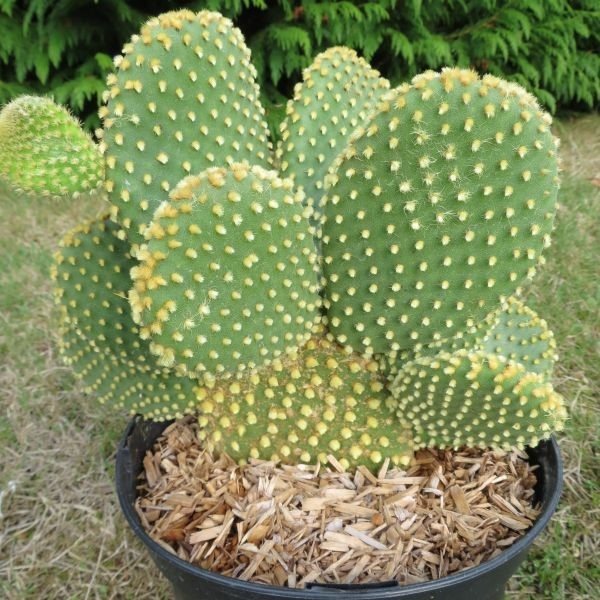

Do not grow prickly pears in the nursery. Fine and fine bristles can dig into the skin and cling to clothing.
Distribution area
Where do cacti grow? Their main habitat is the deserts of North and South America. The most exuberant variety is found in Mexico, Peru, Bolivia, Chile and Argentina. You can also find them in Africa and Asia. Many species have been brought to Spain, Italy, France, Australia, India and Russia. Although the homeland of the indoor cactus is South America, it can take root on almost any continent, if the necessary conditions are created for its life. For example, this plant does not like cold weather.


Cacti also live in highland deserts, adapting to the harsh climate. For example, mammillaria, neobessiya, escobaria, telocactus and other species. There are whole thickets in the savannas. There you can find cereus and prickly pears. But not always the habitat of a cactus is a desert. It is often found in evergreen rainforests. A distinctive feature of such plants is the complete absence of thorns.
Asceticism and beauty
Desert cacti are extremely unpretentious and very profitable plants for growing at home. Minimum effort, no difficulties and maximum pleasure from contemplating beautiful cactus carcasses.
Posting about a cactus will help you compose a text description about a cactus, a perennial prickly plant. A report on a cactus grade 2 can add interesting facts.
Cactus message
Cacti belong to the Cactus family, which includes more than 2800 species. There are 3 subfamilies: Opuntia, Cereus and Peres.
Where do cacti grow?
Some plants grow in Europe, in the Mediterranean regions, in the tropics of Africa, on the island of Madagascar. Also, the cactus can be found in Australia and on the southern coast of Crimea. They are bred as ornamental plants outdoors, in greenhouses and rooms.
Cactus: a description of the appearance
Cacti are perennial plants that have juicy, thickened and fleshy stems. They are covered with spines, bristles, or hairs. In most species of cactus, the fruits are berry-like, fleshy, some even edible. Due to the fact that plants grow predominantly in the desert, they are devoid of foliage. The leaves turned into thorns, water began to accumulate in a massive thick stem. Speaking of thorns. They have different shapes - flat, round, straight or hooked, fluffy or smooth. Although some species of the family have leaves. So, pereskia, which grows in South America, Mexico, India, has a woody stem, leaves and ... thorns. Other plants, prickly pear, have small leaves 2-5 mm long. Outwardly, they resemble an awl and are very juicy. Leaves germinate in spring and dry up and fall off after a short time.
Cacti accumulate even a small part of the water that has entered the soil. Young shoots can pick up moisture even from the air. Then they fall off and take root. The largest cacti can hold up to 2,000 liters of water. And so that less moisture evaporates, the plants are covered with a thick green skin, and on top of it - a hairline or a layer of wax.
Cacti are widely used in medicine. They are used to make drugs for the treatment of cardiovascular diseases, rheumatism.
Interesting Cactus Facts:
- Christopher Columbus in his notes mentions the melon that the aborigines he met ate. But, in fact, they were cacti.
- Cacti are raw materials for the production of shampoos, sweets, alcoholic beverages, soaps, vitamins and other things. Waste from production is fed to pets.
- Farmers in Mexico feed their cows prickly pears, which have been peeled from thorns in advance, so that the animals give more milk.
- In Bolivia and Paraguay, baked Weingartia / Neowerdermannia cacti are a real delicacy.In Mexico, candied pieces of the cactus Melocactus oaxacensis are also a local delicacy.
- In the past, sterilized cactus needles were used by doctors in Latin America to suture wounds.
- The thorns of the plant ionize the air.
We hope that the essay about the cactus has helped you to find out a lot of useful information. You can add a short message about the cactus through the comment form below.
Start in a straight line
It is better to draw the desert with colored pencils. Since you have to represent a large space, it is better to lay the sheet horizontally. In the desert, the skyline is visible from almost everywhere. It is with her that you should start. Draw a horizontal line approximately in the middle of the sheet, connecting its short sides. At the first stage, you can draw it with a hard, simple pencil.
The horizon doesn't have to be perfectly flat. It may have bulges and depressions.
Cactus drinks and dishes
Mexicans use cacti not only as a hedge against unwelcome guests, but also eat them. The fact that some species of cacti have edible fruits has been known since time immemorial. Indians ate sweet prickly pears instead of fruits, and the leaves of the plant were pickled like cucumbers.
It is known that cacti are rich in many vitamins and minerals necessary for the human body. Mexican healers claim that eating these thorny plants can lower cholesterol, boost immunity, and even cure diabetes.
Today cacti are used to prepare salads, hot snacks and sweet desserts. Cacti are boiled, fried, pickled, and also baked with meat and vegetables.
The most popular drink made from the juice of one type of cactus, blue agave, is Mexican tequila. There are several varieties of tequila in terms of strength and composition. Tequila, which is 100% blue agave juice, is especially appreciated.
Mescal is another type of strong Mexican drink made from cacti. And if tequila is made only from blue agave juice, then mezcal can be made from various types of agave with the addition of spices. Often, mezcal is served with a caterpillar at the bottom of the glass, which confirms the high quality of the drink with its color.
Opuntia is a large genus of the cactaceae family with an unusual flat stem shape and tasty fruits. The Aztecs called this cactus "napal", which translates as "fruit". In Israel it is called "sabres". Apparently, this name is associated with the peculiarities of collecting its fruits because in Hebrew this word means "patience". And the Soviet poet V.V. Mayakovsky, this cactus was associated with ears with warts.
There are several theories about the common name of the genus. In the ancient Greek city of Opus, prickly plants were called prickly plants that grew everywhere. Later, opuntia was christened a whole genus of cacti. But nobody knows for certain. It is also possible that the name comes from the word "opos
", Which is translated from Greek as"
fig juice
", Recalling the delicious fruits of the plant.
This genus of cactus has attracted the attention of botanists and the population not only due to its appearance, but also due to the benefits that are derived from it. Opuntia is grown as a hedge, used in the production of dyes and as food for pets, eaten, and also used in folk medicine and cosmetology.
HISTORY OF OPUNTIA
The world learned about prickly pears in the 15th century, when America was discovered - the birthplace of many types of cacti. The first to describe the eared thorn was the court physician of King Philip II Francesco Hernandez in his work “Plant history in New Spain
“After the expedition of 1571-1576.
A special attitude towards prickly pears has developed in Mexico, where more than half of all types of prickly pear grows. The national emblem of Mexico depicts an eagle sitting on a prickly pear and pecking a snake.According to legend, on the site of the current Mexican capital Mexico City, the Aztecs founded the city of Tenochtitlan, whose name literally translates as "the place of the sacred prickly pear". Mexicans appreciate the prickly pear dishes. The peeled leaves of the plant are added to salads, soups, tacos. Fruits and juice are used to make preserves, jams and syrups. Food coloring is made from the juice.
After the prickly pear was brought from the subtropical and tropical places of South America, this amazing viable plant has acclimatized in Europe, India and Russia (in the Caucasus). The history of prickly pears in Australia is interesting. The warm climate was to the taste of the cactus so much that whole fields of prickly pears appeared unnoticed by the inhabitants. After the area of thickets began to amount to several million hectares, the Australians were forced to create a Commission for the control of prickly pears, which existed for 150 years. They fought with both felling and chemicals, but the balance was restored only with the help of a moth moth caterpillar specially brought from Argentina. Later, a monument was erected to the heroine butterfly.
While searching for methods to combat the annoying plant, the Australian Government turned to Luther Burbank, a breeder who experimented with prickly pears in the early 20th century. His goal was to breed a fast growing thornless cactus that would serve as good feed for livestock. He crossed over 600 varieties of cactus until he got the desired result. From one hectare of land, his cacti were supposed to give 200 tons of mass. But prickly pears without thorns were not further spread, remaining in his garden as outlandish plants.
BIOLOGICAL DESCRIPTION
Opuntia
grows in the form of a bush, reaching a height of up to 4 m. Its flat fleshy stems resemble the shape of a flat cake, which are covered with thorns. The thorns grow from the areas, from which glochidia and new processes - babies - also appear.
Glochidia are tufts of hooked hairs that easily cling to the skin, clothing, and hair of an animal. Their main function is protective.
Opuntia blooms beautifully with large red or yellow flowers. After flowering, juicy fruits are formed. Mexicans call them tuna. Length 5-10 cm, weight 70-300g. All manipulations with the plant must be carried out carefully, since the fruit is also covered with thorns. It ripens within two months. Mature tuna has a red-burgundy hue.
SOME TYPES OF OPUNA:
— White-haired (O. leucotricha)
- so named because of the white thorns, which look like down from the side. Plants of this species reach 5 m in height. The flowers are large, yellow.
— Berger (O.bergeriana)
- has large, slightly angular stems, up to 20-25 cm long. Flowers are bright orange-red, hiding a greenish pistil.
— Cylindrical (O.cylindrica)
- its peculiarity is the cylindrical shape of the trunk, the thorns are soft (rudimentary leaves). Grows up to 1.5 m in height.
— Indian (O.ficus-indica)
or "Indian fig" - height up to 4-5 m. Pear-shaped fruits are covered with thorns, but they are edible.
Types of desert plants with names and their photos
A large number of home cacti are desert... They are not afraid of sudden changes in day and night temperatures, prolonged drought and poor soil, but they definitely need sunlight for life. There are many types of delightful desert cacti.
Ariocarpus
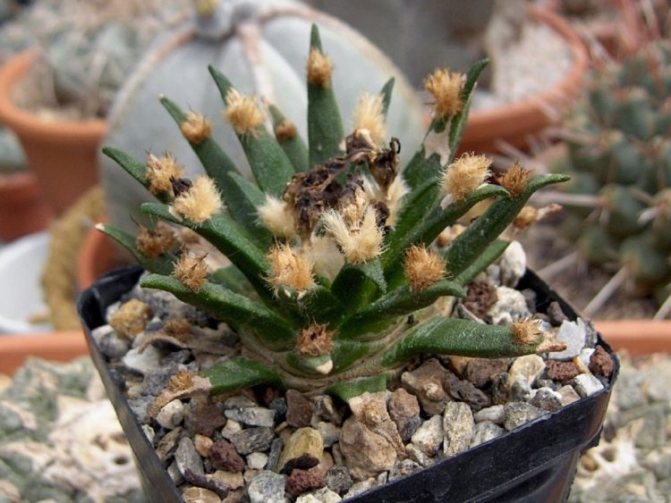

The genus of cacti Ariocarpus has 6 species. The plant has a very low, flattened-spherical stem of a grayish-green color. Some species have white thin stripes on the trunks. Its entire surface is covered with large, triangular hard tubercles, in the sinuses of which there is fluff.
Bell-shaped flowers are:
They appear near the top of the stem. The short flower tube opens wide.
Gymnocalycium
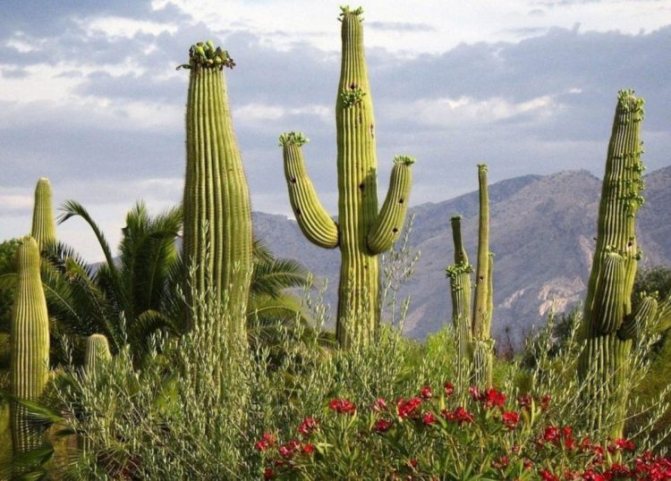

Desert cactus Gymnocalycium in Latin is called "gymnos" and "calycium". Translated into Russian "naked" and "cup".
The stem of the Gymnocalycium can be:
The ribs are divided by transverse knobs. There are some very curious varieties that do not contain chlorophyll. The color of these varieties of Gymnocalycium is:
Cleistocactus
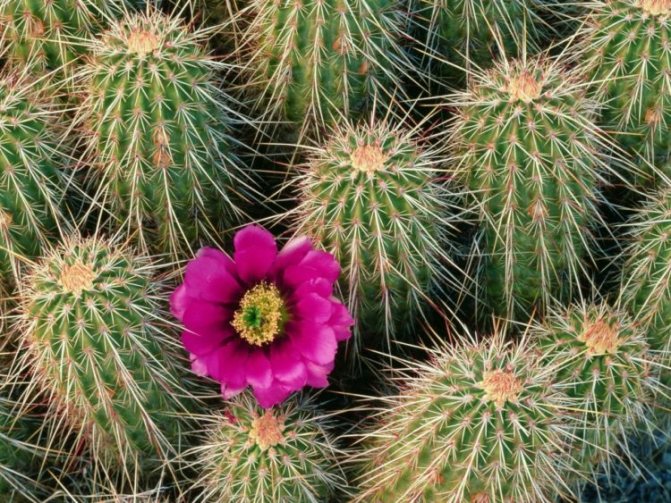

Desert cactus Cleistocactus, translated from Latin Cleistocactus means "closed". It was named so for the peculiarity of the tubular flowers that hardly open. Cleistocactus have long cylindrical stems and thin, dense spines.... They are distinguished by rich flowering. An interesting variety of this cactus is Strauss's cleistocactus. It is unpretentious and does not require special care, and the exotic columnar stems organically fit into the modern interior.
Mammillaria


A very common type of desert cactus is Mammillaria. His stems are collected in round and small groups. Mammillaria stands out for its non-sharp spines. It blooms with small flowers of different shades, forming a spiral on the tops.
We offer you to watch a video about the Mammillaria cactus:
Parody (Parodia)
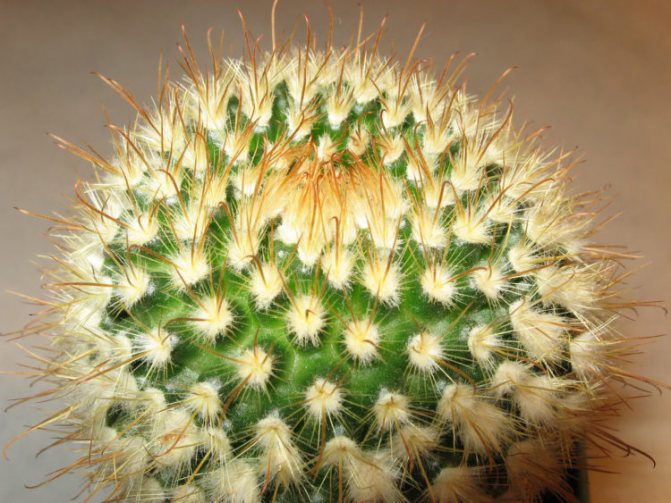

Desert cactus Parody grows small in size - from 15 to 20 cm. Depending on the species, the stem is different, for example, spherical or short cylindrical. Parody blooms for a very long time. The ribs are twisted in a spiral, they are divided into tubercles.
Flowers are different in color:
- copper red;
- fiery red;
- golden yellow.
Matucana
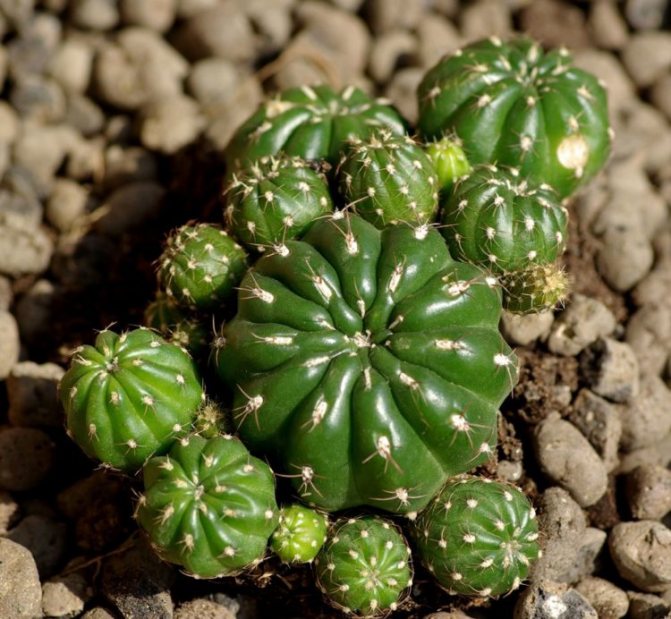

The genus of desert cactus Matucan is named after the Peruvian province. It has about 20 plant species.
The ribs of this type of cactus are from 21 to 30 pieces, they:
- lumpy;
- low;
- arranged in a spiral.
Five-centimeter long radial spines, of which there are from 15 to 30, can be straight or curved. They are colored white, black, gray or tan.
There may not be central spines, and if there are, then there are 10 of them, 1-7 cm long, in color and shape they coincide with the radial ones. The Matukana blooms with flowers in the form of a funnel. There are bright pink, red or crimson flowers. The green globular fruits are pink in color.
Lophophora


The native land of the desert cactus Lofofor is Central Mexico.... The plant stands out in that it looks like a pumpkin. There are practically no thorns on the rounded stem of this cactus, the surface is smooth.
One of the most interesting varieties of this cactus is Lofofor Williams. It is of particular interest to gardeners, and the juice of this plant has a healing and tonic effect.
Rebutia


Rebutia cacti are small plants that grow in groups. They are covered with spines with a spherical stem. Ribs of small height are located on the surface in the form of a spiral. The rebutia is distinguished by abundant flowering. In this case, the flowers at the bottom of the stem form something like a spiral. You will learn more about all types of this plant by reading this article.
Cephalocereus


Cephalocereus is the most unusual and original cactus... It is distinguished by very thin long white, sometimes wavy spines. Thanks to this feature, the people call this cactus "the head of an old man." It must be borne in mind that he injects rather painfully.
Houseplant cactus report
Cactus Are some of the most ancient plants on our planet. They appeared on Earth many - many years ago, when dinosaurs still lived on the planet.
These plants have a trunk of various forms - there are rounded, similar to hedgehogs. And there are straight ribbed trunks. All cacti have one feature in common - instead of leaves, most of them have thorns. The thorns can be small and located throughout the trunk of the plant, or they can be rare, but larger in size. Some types of cacti simply have very large thorns, which can easily be damaged by a person or an animal.The needles of these plants serve to protect against damage by animals and for reproduction: the thorns are attached to the fur of animals or the clothes of people and are transported over long distances.
Different types of cacti are used by people in different ways. There are cacti - medicinal plants. Large tree cacti are used as hedges. Also, cacti are used as ornamental plants - indoor, greenhouse or to create beautiful compositions in flower beds.
Cacti of low species are used as indoor plants. With good care, indoor cacti bloom with beautiful delicate flowers. Some types of cacti bloom exclusively in the dark and only for a few hours. Lovers of indoor cacti collect them in collections around the world, exchange them, and develop new varieties.
In wildlife, cacti grow only in warm and sunny climates - in America, in Africa, in India. Cacti are not afraid of prolonged drought, as these plants can accumulate water in their trunks during the rainy season. In the open air, certain types of cacti grow to the size of huge trees or grow in the form of large thorny pillars.
Cactus - a very beautiful and unusual plant.
Popular talks
False Dmitry I is a legendary person, capable of persuading the people to his side, raising them to their side, and, being an impostor, seizing the royal throne.
A jet engine is a machine that converts an energy-rich liquid fuel into a powerful pushing force called thrust. The thrust from one or more engines propels the plane forward, forcing air to flow along the wings,
In the sultry desert under the hot sun, where, at first glance, nothing can survive, desert cacti stretch upward.
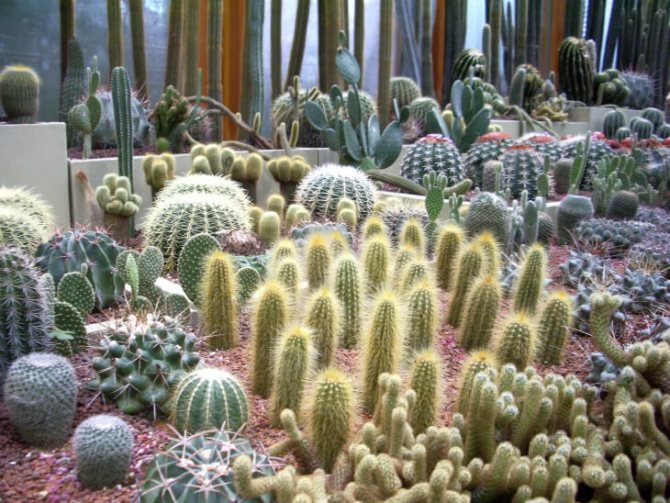

Option 2
Cactus is a perennial flowering plant belonging to the Clove group. Plants evolved about 30 million years ago, at which time it acquired the form we are accustomed to. The habitat of cacti is the countries of the New World. They are widespread in the Americas and the West Indies. They are found in Africa, on the island of Madagascar and in Sri Lanka, where they were introduced by migratory birds. Since the cactus is a very unpretentious plant, today it can be found on all continents in botanical gardens or in private collections of indoor plant lovers.
In Greek culture, the word "kaktos" was used to denote plant species unknown to scientists. Later, Karl Liney began to use this word to classify cacti.
Plants of the cactus family come in different shapes (from spherical to cone-shaped and elongated). They grow in desert areas. The root system of a cactus consists of two parts: surface roots and roots that go deep into the ground. The climatic conditions of deserts form large temperature differences, due to which moisture falls in the form of dew. Surface roots, whose length reaches 5 meters, collect this moisture, allowing the plant to do for a long time without irrigation and rain.
The second type of roots holds massive cacti above the ground. Such a root has an impressive size, so even during hurricanes, plants do not suffer from gusty winds. However, it does not reach groundwater and therefore mainly serves only as an “anchor”.
The stalk of a cactus is capable of storing water. It can be ribbed or smooth. On its surface, depending on the type of cactus, bristles, thorns or leaves are formed. They are modified kidney scales of the stem tissue. Large cactus flower has a pleasant aroma. It contains areoles in the form of spines and hairs.
Since ancient times, people have been using the fruits and stem of the cactus for food. It is used as a medicine. It also serves as a building material and a hedge.Dwarf cactus species are grown in homes as an ornamental plant.
Features of plant care
With proper care and timely picking, cacti will look healthy and will delight your eye with their extraordinary color. We must not forget that cacti stand out from other houseplants, so excess water in the ground can cause the death of a cactus, and the summer heat and dry soil will “send” the cactus into hibernation.
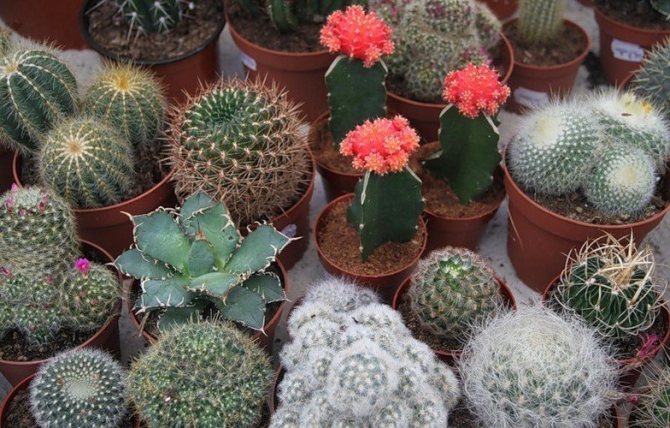

In order for cacti to grow easily at home and bloom, they need a low temperature in winter, and in summer - a shaded room, moderate temperature (up to 25 degrees Celsius) and sufficient watering.
Air temperature
The air temperature should be mild from spring to autumn. In winter, it is necessary to maintain the temperature in the range of 15-18 degrees, some cacti have the ability to tolerate 5 degrees Celsius. However, cacti that are on the windowsill in an unheated room on cold nights are safer to move to a warmer room.
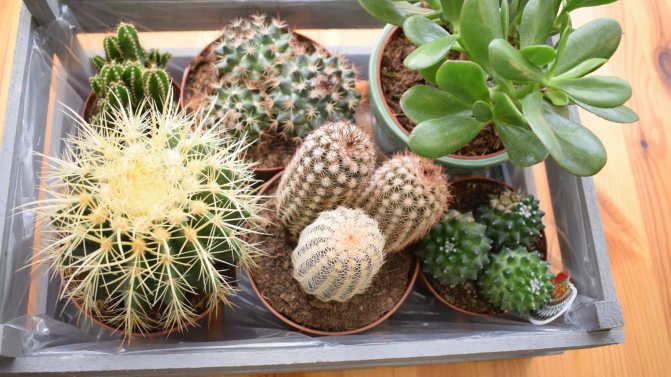

Watering and humidity
The main rule of watering: it is better not to top up than to overflow. In the spring, watering begins to increase, in the period April - August, watering should remain the same as for ordinary house plants (provided that the room is warm and sunny) - as the earth dries up. Water the cacti with soft and warm water. At the end of summer, watering is gradually reduced, and from the middle of autumn it is watered quite rarely and little by little (with tablespoons).
Cacti do not need to be sprayed (except for Cleistocactus, they can be sprayed); on sultry sultry days, they do not spray the plant, but near it.
Soil and transplant
For cacti, as a rule, earthen mixtures are used in equal parts of compost and sand with the addition of coal and peat. Such a mixture of soil is loose, airy and rather moist. The chemical composition of the soil, for different varieties of cacti, needs the same proportions of mineral and organic components, but the acidity should be low.


Young cacti are transplanted every year, 3-4-year-olds - every couple of years. It is advisable to transplant at the beginning of the growing season. The new pot should be 1 cm larger than the previous one. Before picking (for two to three days), do not water the cactus, the soil will easily fall off the roots.
In order to get a prickly cactus from a pot, wrap it in paper, or wear gloves. Do not water or keep in the sun for a couple of days after the pick. The choice of a cactus pot should match the size of the root system.
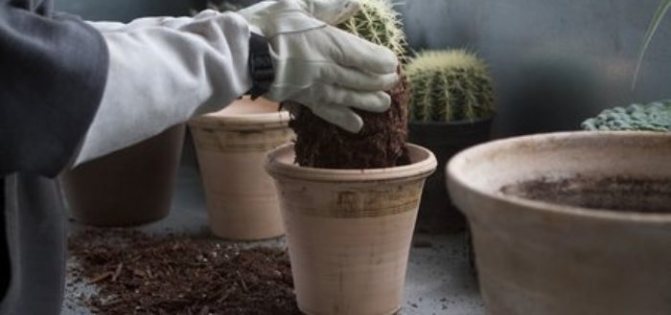

If the cactus has short roots, choose a low pot, but cactuses with a huge root require a deeper pot. Cacti are bred in plastic pots (the soil dries out more slowly, and it is better to plant fresh plants that take root in such pots), but this is a completely optional condition, the pot can be earthenware (the soil dries out faster and gets cold after watering), or glass (usually used for decor). Any pot must have a drainage hole to drain off unnecessary water - this is probably one of the most important conditions for growing succulents.
Reproduction
Most of the desert cactus species reproduce in vegetative age or in spring. Cactus cuttings are cut (they already have rudimentary roots), dried for 2-4 days before planting in a mixture on a peat basis, after a short time the cactus will develop a root system.


Similarly, cacti are propagated by seeds. Breeding cacti from seeds is a serious and rather painstaking job. Most importantly, the purchased seeds must be disinfected in a solution of potassium permanganate. Then cover the soil in a small layer up to 1 centimeter and spread the seeds. The soil should always be moist, so it should be covered with glass or foil - this will create the right conditions for seed germination.
Based on the type of cactus and the characteristics of the seeds, the duration of germination can last from a day to a couple of months. As soon as the first spines form in the plants, they should be planted in single pots in the most nutritious substrate. At the age of a couple of months, young cacti ask for the same care as other cacti. It is recommended to sow seeds at the end of winter, so that seedlings emerge in early spring.
Blooming cactus
The flowering stage of many cacti is not combined with the stage of active growth. Some cacti (Lobivia, Parodia, Notocactus ...) bloom quite often at a young age, while others such as Opuntia and Cereus very rarely please with their color. Flowering of cacti can be expected at about 3-4 years of age, then they should bloom annually.


The secret of cactus blooming is in fresh shoots, in which flowering buds are laid, and this implies proper care in summer and winter. It is extremely important to keep the plant in a cramped pot to activate the flowering of the cactus.
Hills and depressions
The wind in the desert is not so rare. It transfers masses of sand from one place to another. Irregularities are formed - sandy hills, which in some regions are called dunes. The dunes can have different heights. Note that in the painting, objects that are closer to the viewer appear larger than those in the background.
On the surface of the sheet, on which the horizon line is already drawn, the near objects will be located below those in the distance. Draw several dunes on different planes. They can be depicted as obtuse angles, the tops of which look up.
The corners can be slightly rounded. Sandy hills can also be drawn in the form of arcs, the convex parts of which are directed upwards.
Message 3
Planet Earth is known for a variety of plants, which have their own characteristics and unusualness. One of the most popular and unusual flowering plants is the cactus family. Scientists - botanists are trying to determine the time of the formation of cacti, although no fossil remains were found, but presumably they grow on the earth already 30 million years ago.
The etymology of the word is known only by the fact that in the ancient Greek language another plant was called that, which is now unknown to science. Since 1771, cacti have been used to denote green plants, the surface of which is covered with thorns. Even earlier they were called melocactus, and then they simply abbreviated this name.
The origin of cacti comes from South and parts of North America. Migratory birds brought cactus seeds to Africa and Asia. Later, people began to spread the plant around the world. Nowadays it is common for cactus to germinate in any part of the world except Antarctica. Undoubtedly, the cactus prefers warm places, because its homeland is the desert, where there is a minimum of moisture and a maximum of sun. In Russia, cacti are found in the south, in the Crimea and the region of the city of Gelendzhik.
Not all cacti are similar in structure and are closely related. The main cactus family has a special organ - a halo. It resembles a kidney. The fruit and flower of the cactus is part of the stem, which is not typical of other plants. Areoles resemble thorns in appearance and the hairs are also called kidneys, since they collect moisture from space and are able to keep it inside for a long time in order to maintain life. Moreover, the fetus has no needles.
All cacti differ from each other in shape and height. It depends on the habitat. For example, there are cacti that grow in prescription forests, and there are those that are adapted to drought - such are cactus growths can be up to 4 meters. Their weight can be several tons, depending on the amount of moisture contained in it.
Botanists divide all cacti into 4 groups: pereskivye - a cactus close to deciduous plants. He also became the starting point in the development of other types of cactus.
Opuntia - cacti with pronounced large leaves.
Mauhyeny are widespread in Patagonia with no thorns.
Cactus - they are distinguished by the complete absence of leaves, the plant itself is round in shape.
Why is there a cactus on the flag of Mexico?
There are several explanations for why the cactus is depicted on the flag of Mexico.
The first is associated with an ancient legend about how the Aztec Indians founded the city of Tenochtitlan, which later became the capital of the Mexican states of Mexico City. After long treks through the mountainous terrain in search of a suitable place for a new city, the Indians decided to take a short break near Lake Tescoco. One of the noble sons of the tribe saw an eagle on top of a huge prickly pear growing on an island in the middle of a lake. The bird of prey held a poisonous snake with its claws and tore it apart with its beak. The Aztecs considered this a good sign from the gods and decided to found a city on the banks of the Tescoco. Tenochtitlan played an important role in the state life of the Aztecs, and the Spanish conquistadors who came to this land made it their capital.
The second reason why the Mexicans value prickly pear so much that they depict it on their flag is its widespread use in the country's industry. The income from the processing of cacti significantly replenish the treasury of Mexico, and tens of thousands of farmers are engaged in their cultivation. Opuntia is used for food, dyes, medicines and cosmetics are made from it.
How to convey space
Regardless of whether you are drawing a desert with a simple pencil or colored, you need to convey the features of the landscape. This is best done with shading. Apply strokes in different directions. For example, you can draw a dune with long lines extending downward. Another method will also look good - overlaying groups of strokes going in different directions over the entire surface.
In the sky, it is enough to draw a few free lines parallel to the horizon. Trees and animals can simply be outlined with a softer pencil. Keep in mind that foreground subjects appear brighter and sharper. Objects farther from the viewer appear lighter and have slightly blurred outlines.
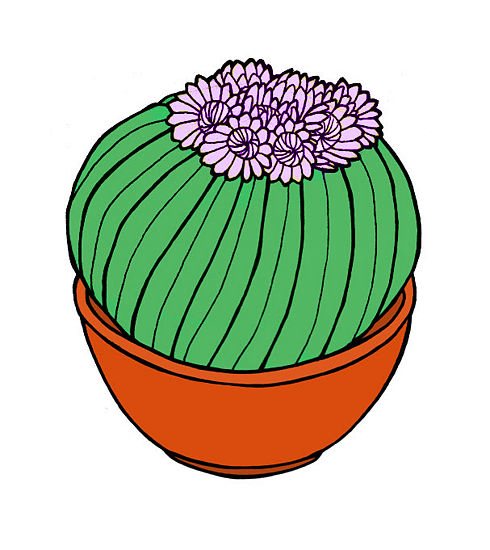

This article will show and tell you how to draw a cactus. Any person can depict a flower, for this it is enough to break the drawing into simple shapes: a circle, a straight line, a curve, a cylinder, an ellipse, etc. Using this approach, it will be quite easy to depict this exotic plant.
Draw with a pencil
We continue to learn how to draw a cactus with a pencil.
In the center of the sheet, draw with a pencil something in between a rectangle and an oval. On the sides of it there are drop-like processes, from each of which there are a couple of small processes.
Draw vertical lines throughout the flower. Mark the thorns on the trunk and processes with small frequent strokes.
Color the drawing. With dark green and light green colors, give the plant volume, and at the base, barely mark the soil with light brown shades.
general description
The barrel has a round ribbed appearance... Since there is a similarity to a ball, the evaporation of moisture from the surface in this case is very small. And the ribs swell during the wet period, helping the owner to absorb as much water as possible, while not cracking or bursting. Succulents are used to living in poor dry soil, and waterlogging is extremely dangerous for them.
For sun protection some have very thick skin, others spread out strongly in breadth to create shade for the main stem. There are also species that seem fluffy due to the large number of spines or hairs that completely cover the plant, leaves are missing.
The adaptability of the cactus to the habitat
Nature has endowed cacti with grooves. Through them, water rolls down to the roots, which are thickened in order to store as much moisture as possible. They can occupy up to 5 square meters around the plant. At the same time, superficially lying roots absorb dew and moisture from the soil.
The adaptability of a cactus to its habitat depends on the growing area. For example, due to the spherical shape, low evaporation of moisture is achieved. And the ribs on the stem prevent cracking. A thick skin saves the cactus from the hot sun. Some species are covered with many thorns and villi that create a protective shade. For plants "living" in deserts, nature has provided for the absence of leaves in order to save precious moisture.


Why do flowers survive in such conditions and how do they grow?
Thorns are of great importance in terms of the survival of cacti in the desert. It is they who prevent animals from eating this plant. In addition to protection, spines and hairs collect moisture. They are able to absorb water droplets that settle in the form of dew. For most desert cactus species, this is the only way to extract moisture in arid regions.
For a long time, desert cacti decorated exclusively these lands. However, today they can often be found at home with lovers of these plants. This is proof that desert cactus species adapt well to various living conditions.
If you find an error, please select a piece of text and press Ctrl + Enter.
Cacti are a separate family of flowering perennial plants of the order Clove. They are divided into 4 subfamilies. It is believed that evolutionarily cacti appeared about 40 million years ago. However, fossils of such ancient specimens have not yet been found. Scientists are inclined to believe that the homeland of the indoor cactus, as well as other species, is South America, and it appeared relatively recently, about 10 million years ago. And only then it began to spread throughout North America.
Today these plants are very popular among fans of indoor flower cultivation. In addition, there are many rumors that cacti absorb electromagnetic radiation from household appliances. Therefore, many people place them near their computers. However, this information has not been officially confirmed by scientists.
Several interesting compositions
The work is one of the most colorful in the writer's work and tells about the life of ordinary village people with their original and incredibly difficult fates.
With the work of Nikolai Vasilyevich Gogol, many have childhood memories of the terrible blind Viy and the terribly beautiful panochka. At school, having become acquainted with other works of the writer, we realize how individual
Alexey Ivanovich Shvabrin is a secondary and negative character in the story "The Captain's Daughter". This is a young, educated officer from a wealthy family.
The Kirsanovs are among the central characters of the famous work of Ivan Sergeevich Turgenev. In this discussion, we will compare the two brothers and try to identify their similarities and differences.
All people in one way or another strive for their dream. Someone dreams of living in a luxurious house, someone wants to drive through the city in a red Mercedes, for someone a delicious dinner is already the embodiment of all desires. However, there is another side to life


